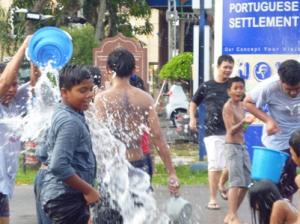Malacca Portuguese Creole: A Portuguese-based Creole

Landing page image for the collection “Malaccan Portuguese Creole: A Portuguese-based Creole”. Click on image to access collection.
| Language | Malacca Portuguese Creole, Kristang |
| Depositor | Stefanie Pillai |
| Affiliation | University of Malaya |
| Location | Malaysia |
| Collection ID | 0123 |
| Grant ID | SG0138 |
| Funding Body | ELDP |
| Collection Status | Collection online |
| Landing Page Handle | http://hdl.handle.net/2196/782cee90-6092-427a-ae84-18d14cbfe9ff |
Summary of the collection
Malacca Portuguese Creole (MPC) is an endangered language spoken by people of Portuguese descent. Currently, the largest concentration of MPC speakers is in the Portuguese Settlement in Malacca (or Melaka) in the central part of Peninsular Malaysia with an estimated population of 1000 people who are largely Roman Catholic. In the early 1930s, a settlement for people of Portuguese descent in one location on the coast of Melaka was established by two Catholic priests, Father Alvaro Manuel Coroado and Father Jules Pierre Francois, hence the MPC name of the settlement: Padri sa Chang or Priests’ Land (O’Neill, 2008). This enclave is popularly known as Kampung Portugis (Portuguese Village) in Malay (the national language of Malaysia). The Settlement is a popular tourist destination with numerous restaurants serving Malacca Portuguese food. There is also a museum showcasing artefacts, images and clothes related to the history and culture of the community. The costumes and dances that tourists typically associate with the community tend to be those introduced in the fifties by a Portuguese priest (Sarkissian, 2005). The hybrid of Portuguese-imported music and dance and more traditional elements of song and dance such as the mata kantiga and branyo are part of the uniqueness of this community, as are celebrations such as Intrudu (a water festival marking the beginning of Lent) and Festa San Juang (Feast St John) and Festa San Pedro (Feast of St Peter).
MPC is a Portuguese based creole that can be traced back to the arrival of the Portuguese in Melaka in 1511. The intermarriage between the Portuguese and locals resulted in a hybrid community whose descendants continue to exist in Malaysia (see Baxter, 2005). The number of speakers of Malacca Portuguese Creole has declined over the years, and even in a contained area like the Portuguese Settlement most community members under the age of forty are not fluent in MPC. Sociolinguistic studies have shown that there is evidence of language shift to English at the Settlement (David & Noor, 1999; Pillai, Soh & Kajita, 2012; Sudesh, 2000). The language itself is showing evidence of disappearing lexical items, uses of Malay and English forms (Baxter 2012), and variation in pronunciation (Chan & Pillai 2012), which are signs of language loss.
Despite this, MPC is among the last Portuguese-based Creoles still in active use in the East and there is an immediate need to document the language and its inherent culture. Whilst there have been efforts to keep this language alive through the publication of dictionaries and phrasebooks (e.g. Baxter and de Silva, 2005; Marbeck, 2004, 2012), there is a need for an accessible archiving of the language and insights into the people and their culture. It is also important that the community is involved in providing the audio and video data and agree to have it shared.
The collection includes video and audio recordings conducted at the Portuguese Settlement from 2011. The audio and video files are paired with time-aligned orthographic transcriptions in MPC and their English translations which were carried out by a native speaker consultant. The transcriptions are largely based on the spelling conventions suggested in Baxter and de Silva (2005). They are still a work in progress and will be amended periodically as they are checked by other native speaker consultants. More data will be added in 2013.
Group represented
Portuguese-Eurasians
Language information
Kristang, Cristang, Papiá Cristang, Papia Kristang, Malaysian Creole Portuguese, Serani, Bahasa Serani, Bahasa Portugis, Malayo-Portuguese, Portuguese patois, dialecto Portugues de Malaca
Special characteristics
The spelling conventions used to transcribe Malacca Portuguese Creole (MPC) are adapted from Baxter and de Silva (2004). The spelling is based on Malay which has a phonemic orthography – words are generally spelt the way that they are pronounced. However, this does not in any way indicate that this is the standard spelling convention for the Creole.
Some points to note about the spelling conventions used:
1. In modern Malay spelling, the first sound in a word like chair is spelt with a ‘c’, for example, ‘cikgu’ (teacher), ‘cendawan’ (mushroom). However, in the transcriptions, ‘ch’ is used to avoid confusion with English spelling and pronunciation.
2. Words that are stressed in the final syllable have ‘h’ added after the vowel, e.g. ‘kazah’ (to marry) and ‘peskah’ (to fish).
Collection contents
This collection contains video and audio recordings of language consultants of Malacca Portuguese Creole conducted at the Portuguese Settlement from 2011. It also contains text files of orthographic transcriptions of the audio and video files in MPC and their English translations and related photographs. It should be noted that the transcriptions and translations are still work in progress.
Collection history
This Documentation of Malacca Portuguese Creole was made possible by a grant from the Endangered Languages Documentation Programme (SG0138). The data were collected together with Chan Min En, Soh Wen Yi and Carrieanne De Costa with the cooperation of the many language consultants who consented to be recorded.
Acknowledgement and citation
Please cite Stefanie Pillai as the collector and ELDP as the funder. Individual speakers should be cited by name if the material they contributed or their images are used.
To refer to any data from the collection, please cite as follows:
Pillai, Stefanie. 2011. Malacca Portuguese Creole: A Portuguese-based Creole. Endangered Languages Archive. Handle: http://hdl.handle.net/2196/00-0000-0000-0001-FDF1-8. Accessed on [insert date here].


